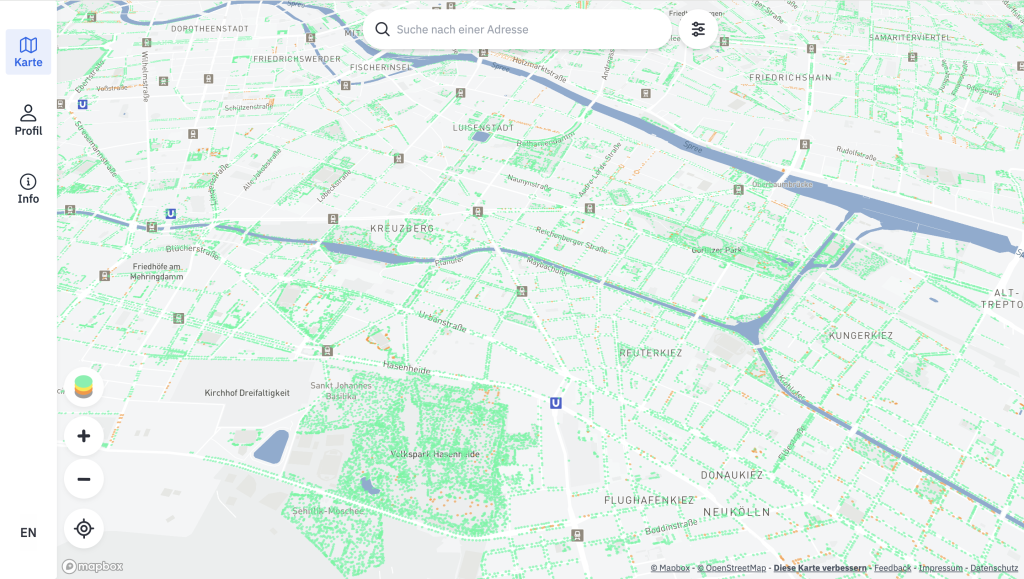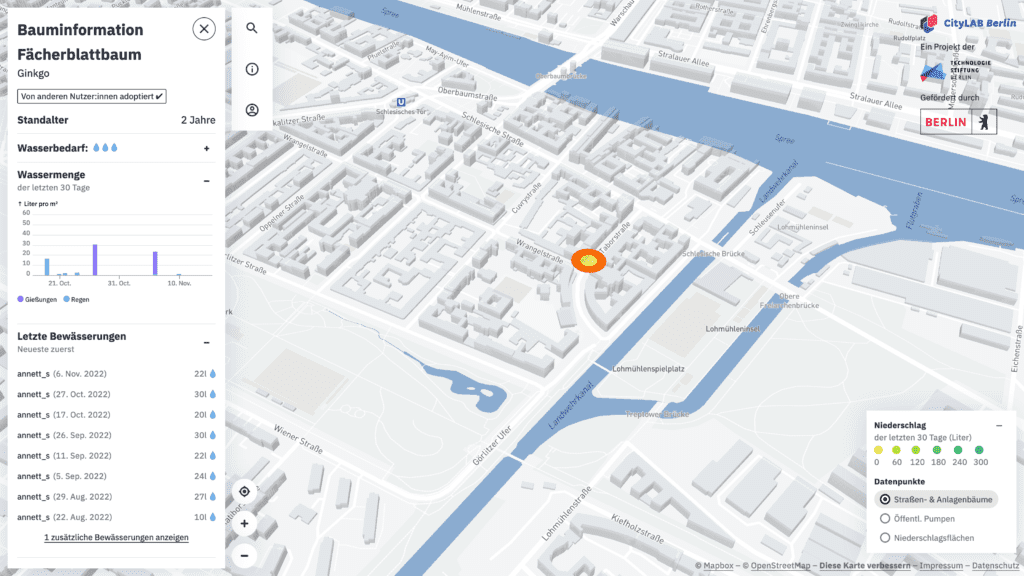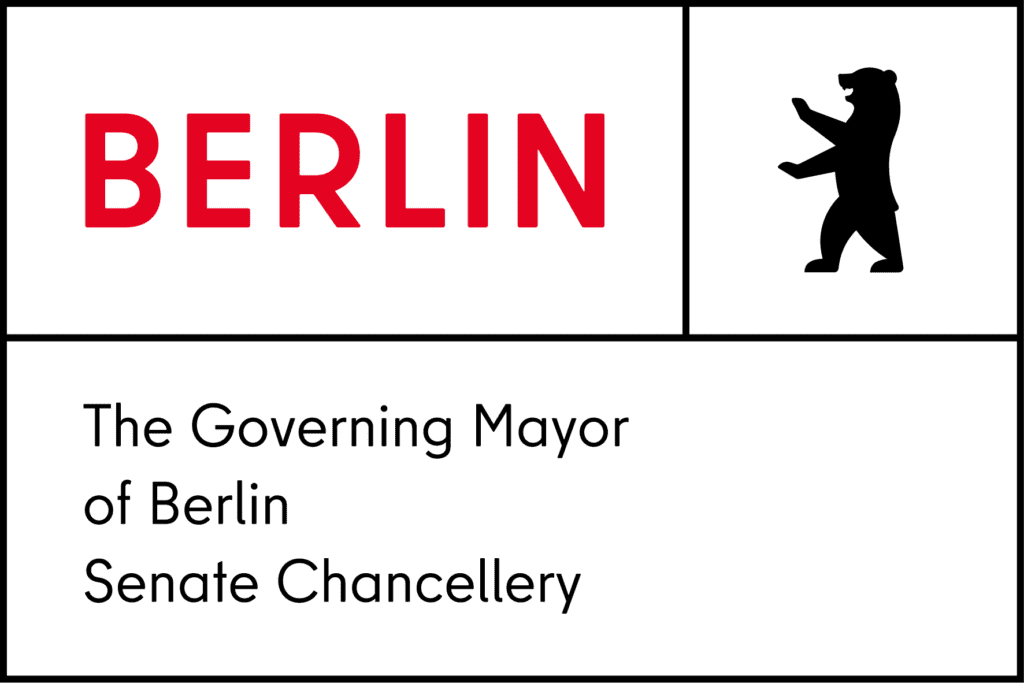Starting point
The consequences of the climate crisis in cities have become noticeable for all of us. The effects are particularly visible when we look at our green infrastructure: parks are more yellow than green in summer and the treetops of some trees appear holey and withered. With Gieß den Kiez (water your neighbourhood), we want to bring together people who want to water trees together and facilitate the transfer of knowledge between all tree lovers.
Approach
With Gieß den Kiez, CityLAB Berlin created an interactive platform in May 2020 to help Berlin’s urban trees and support the city in watering the trees through the voluntary work of civil society. The map depicts almost all of Berlin’s street and park trees with information such as water requirements, age and species and invites all citizens to participate in the watering of our endangered tree population. Citizens can find out about the water requirements of trees in their neighbourhood, create a profile, adopt trees and mark them as ‘watered’ within the app.
Diese Open Data-Datensätze nutzt die App:
Trees: Municipal tree register (status: 2024)
Precipitation: German Weather Service (daily update)
Pumps: Open Street Map (updated weekly)
How does Gieß den Kiez function?
Exploration of Berlin’s tree population: An interactive map visualises exactly 885.825 Berlin trees. Information on the type, age and estimated individual water requirements is provided for each tree. Search and filter functions make it even easier to explore Berlin’s trees.
Adopting and watering trees: The application can be used to directly identify which trees need how much water, depending on their age, urban maintenance and volunteer involvement. Users can indicate when and with how much water they last watered a tree and can adopt it if they want to water it regularly. This allows other people in the neighbourhood to see which trees need their attention.


Filter features: Users can filter the trees according to age, for example, and thereby understand the distribution of the tree population – or simply discover the oldest tree. The colour indication allows you to immediately see which trees in the neighbourhood are thirsty and which are already supplied. With a profile, you can also see your individual watering overview and display your adopted trees directly on the map.
Overview of precipitation: With the help of daily updated data from the German Weather Service, the system displays how much rainwater each tree has received in the last 30 days. The latest update displays this information together with the recorded watering in relation to the estimated water requirement.
Pumps in Berlin: Click on the filters to view Berlin’s Schwengel pumps and their functional status. This means you have to carry less water and save valuable drinking water.
Understanding water requirements: A tree’s water requirements vary depending on its age. Young trees in particular are dependent on support in the first few years. The “Straßen- und Grünflächenämter” (SGA) look after several thousand trees, but sometimes reach their capacity limits. Thanks to the revised display of water requirements in a donut diagram and the colour coding on the map, it is now easier to understand the respective water requirements. For example, it shows that older trees can ideally obtain their water from the groundwater, while very young trees are watered by the SGAs. Those young trees that remain thirsty indicate this by their colour dots. Although this logic only provides an approximation, it can ideally help to coordinate irrigation measures so that the valuable water benefits the thirstiest trees.
Further information: In addition, the platform contains a wealth of useful information on correct irrigation and tree population, as well as relevant links to recommendations from tree caring associations and loal municipalities.
How can I participate?
Tree Lovers
You can simply sign-up, water and register your irrigation online within the app. For the exchange with us and other interested people there is a public Gieß den Kiez Slack Channel in which the community (over 1.000 engaged persons!) exchange knowledge, tips, pics and feedback towards the app.
Interested Cities and Municipalities
If you are interested in setting up your own Gieß den Kiez for your city, we now have the ultimate guide, checklist and retrospective in one for you to download and share digitally. We wish you every success in adapting Gieß den Kiez and would be delighted if you keep us up to date.
If you are looking for more background information on Open Data and the structure of Gieß den Kiez, our video tutorial on YouTube will help you.
To the YouTube tutorial
We are proud that Leipzig was the first city to fork our code on GitHub and implement its own version called Leipzig Gießt. Since then, the city of Magdeburg has also become active with Magdeburg Gießt.
Are you a developer or curious about how the app works in detail? Then visit the wiki in our GitHub repository to do the same for your city. Here you will find all information about data, backend and frontend and can code together with us.
We are proud to share that Leipzig was the first city, that forked our code on GitHub and implemented their very own version called Leipzig Gießt. Since early summer 2023 the city of Mageburg joined our path with Magdeburg gießt. Checkout our GitHub Repository and its manifold Wiki to do the same.
Public Money for Public Code 💚
Contact
App: www.giessdenkiez.de
Email contact: giessdenkiez@citylab-berlin.org
Community Chat: Slack-Kanal
